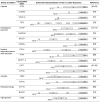Gene expression regulation by upstream open reading frames and human disease
- PMID: 23950723
- PMCID: PMC3738444
- DOI: 10.1371/journal.pgen.1003529
Gene expression regulation by upstream open reading frames and human disease
Abstract
Upstream open reading frames (uORFs) are major gene expression regulatory elements. In many eukaryotic mRNAs, one or more uORFs precede the initiation codon of the main coding region. Indeed, several studies have revealed that almost half of human transcripts present uORFs. Very interesting examples have shown that these uORFs can impact gene expression of the downstream main ORF by triggering mRNA decay or by regulating translation. Also, evidence from recent genetic and bioinformatic studies implicates disturbed uORF-mediated translational control in the etiology of many human diseases, including malignancies, metabolic or neurologic disorders, and inherited syndromes. In this review, we will briefly present the mechanisms through which uORFs regulate gene expression and how they can impact on the organism's response to different cell stress conditions. Then, we will emphasize the importance of these structures by illustrating, with specific examples, how disturbed uORF-mediated translational control can be involved in the etiology of human diseases, giving special importance to genotype-phenotype correlations. Identifying and studying more cases of uORF-altering mutations will help us to understand and establish genotype-phenotype associations, leading to advancements in diagnosis, prognosis, and treatment of many human disorders.
Conflict of interest statement
The authors have declared that no competing interests exist.
Figures


Similar articles
-
Impacts of uORF codon identity and position on translation regulation.Nucleic Acids Res. 2019 Sep 26;47(17):9358-9367. doi: 10.1093/nar/gkz681. Nucleic Acids Res. 2019. PMID: 31392980 Free PMC article.
-
Dual modes of natural selection on upstream open reading frames.Mol Biol Evol. 2007 Aug;24(8):1744-51. doi: 10.1093/molbev/msm093. Epub 2007 May 9. Mol Biol Evol. 2007. PMID: 17494029
-
Translational Regulation by Upstream Open Reading Frames and Human Diseases.Adv Exp Med Biol. 2019;1157:99-116. doi: 10.1007/978-3-030-19966-1_5. Adv Exp Med Biol. 2019. PMID: 31342439 Review.
-
Upstream open reading frames cause widespread reduction of protein expression and are polymorphic among humans.Proc Natl Acad Sci U S A. 2009 May 5;106(18):7507-12. doi: 10.1073/pnas.0810916106. Epub 2009 Apr 16. Proc Natl Acad Sci U S A. 2009. PMID: 19372376 Free PMC article.
-
Regulation of plant translation by upstream open reading frames.Plant Sci. 2014 Jan;214:1-12. doi: 10.1016/j.plantsci.2013.09.006. Epub 2013 Sep 18. Plant Sci. 2014. PMID: 24268158 Review.
Cited by
-
Mechanisms of repeat-associated non-AUG translation in neurological microsatellite expansion disorders.Biochem Soc Trans. 2021 Apr 30;49(2):775-792. doi: 10.1042/BST20200690. Biochem Soc Trans. 2021. PMID: 33729487 Free PMC article. Review.
-
Evolutionarily conserved enhancer-associated features within the MYEOV locus suggest a regulatory role for this non-coding DNA region in cancer.Front Cell Dev Biol. 2024 Jul 30;12:1294510. doi: 10.3389/fcell.2024.1294510. eCollection 2024. Front Cell Dev Biol. 2024. PMID: 39139450 Free PMC article.
-
Translation initiation downstream from annotated start codons in human mRNAs coevolves with the Kozak context.Genome Res. 2020 Jul;30(7):974-984. doi: 10.1101/gr.257352.119. Epub 2020 Jul 15. Genome Res. 2020. PMID: 32669370 Free PMC article.
-
Endoplasmic reticulum stress signalling - from basic mechanisms to clinical applications.FEBS J. 2019 Jan;286(2):241-278. doi: 10.1111/febs.14608. Epub 2018 Aug 4. FEBS J. 2019. PMID: 30027602 Free PMC article. Review.
-
Small ORFs as New Regulators of Pri-miRNAs and miRNAs Expression in Human and Drosophila.Int J Mol Sci. 2022 May 20;23(10):5764. doi: 10.3390/ijms23105764. Int J Mol Sci. 2022. PMID: 35628573 Free PMC article.
References
-
- Mendell JT, Sharifi NA, Meyers JL, Martinez-Murillo F, Dietz HC (2004) Nonsense surveillance regulates expression of diverse classes of mammalian transcripts and mutes genomic noise. Nat Genet 36: 1073–1078. - PubMed
Publication types
MeSH terms
Substances
Grants and funding
LinkOut - more resources
Full Text Sources
Other Literature Sources

